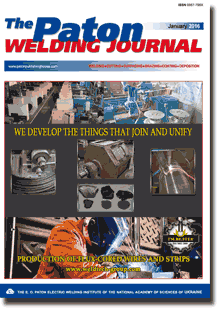| 2016 №01 (03) |
DOI of Article 10.15407/tpwj2016.01.04 |
2016 №01 (05) |

The Paton Welding Journal, 2016, #1, 30-34 pages
Influence of thermophysical properties of cores of self-shielding flux-cored wires on welding and technological properties
A.S. Kotelchuk
E.O. Paton Electric Welding Institute, NASU 11 Kazimir Malevich Str., 03680, Kiev, Ukraine. E-mail: office@paton.kiev.ua
Abstract
In the paper the comparison of effectiveness of gas shielding of molten metal in welding with self-shielding flux-cored wires of carbonate-fluorite type was carried out considering the properties of their cores investigated by thermal analytical methods. It is shown that to improve reliability of gas shielding in welding using such wires it is important not only to ensure generation of large volume of shielding gases at thermal destruction of the wire core, but also to control this process, providing sufficient gas evolution at all stages of heating and melting of the wire. Using the data of differential scanning calorimetry of charge of the flux-cored wire of carbonate-fluorite type containing lithium carbonate, the evaluation of heat losses for heating and melting of powder core, accompanied by the development of energy-intensive processes of thermal destruction of core components, was carried out. It is proposed to limit the carbonate content in the wire at the level of 1–2 % of its weight, that allows keeping the values characterizing the stability of welding process at an acceptable level and, thus, providing a sufficient gas shielding of metal and good separation of slag crust. The control of thermochemical reactions in the core is achieved by selecting its necessary composition to ensure a favorable melting of flux-cored wire and electrode metal transfer to the weld pool. 5 Ref., 3 Tables, 5 Figures.
Keywords: arc welding, flux-cored wire, melting and metal transfer stability, thermal comprehensive analysis, thermophysical properties, welding and technological characteristics
Received: 29.10.15
Published: 15.03.16
References
- Widgery, D. (2005) Tubular cored wire welding. In: New developments in advanced welding, 21–39. Cambridge: Woodhead Publ.
- Pokhodnya, I.K., Yavdoshchin, I.R., Shvachko, V.I. et al. (2004) Metallurgy of arc welding. Interaction of gases with metals. Ed. by I.K. Pokhodnya. Kiev: Naukova Dumka.
- Shlepakov, V.N., Suprun, S.A., Kotelchuk, A.S. (1990) Estimating of the characteristics of flux-cored wire welding under the wind flow effect. In: of Int. Conf. on Welding under Extreme Conditions (Helsinki, Finland, 4–5 Sept., 1989), 171–179. N.Y.: Pergamon Press.
- Shlepakov, V.N., Kotelchuk, A.S. (2011) Investigation of thermochemical characteristics of mixtures of dispersed materials by differential thermal analysis methods. The Paton Welding J., 12, 13–16.
- Ponomarev, V., Al-Erhayem, O., Apps, R.L. et al. (1997) Arc welding process statistical analysis. Methodical approaches, analysis conceptions, experiences: Manual-guide. DTU-Helsingor: JOM-Institute.
